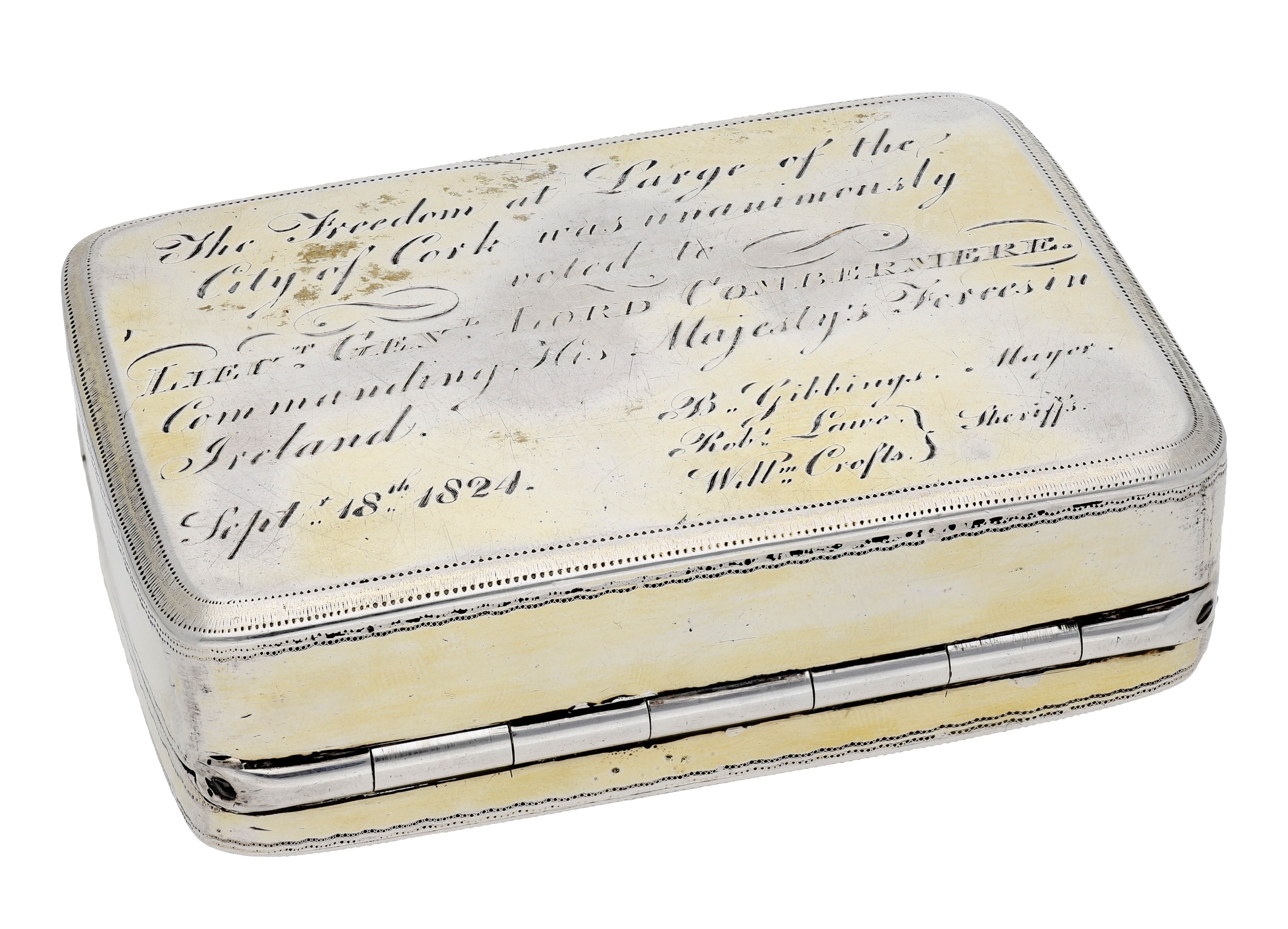A George IV Irish provincial silver-gilt City of Cork freedom box by Richard Garde of Cork, of rectangular form with rounded corners, the flush-hinged cover engraved with Cork City coat of arms with garter, Latin motto ‘STATIO BENE FIDA CARINIS’, flanked by thistles, flowers and harps, with coronets to the corners, and scroll thumbpiece, the base engraved with presentation inscription to Lord Combermere:, reading: ‘The Freedom at Large of the City of Cork was unanimously voted to Liet.t Gen.L Lord Combermere. Commanding His Majesty’s Forces In Ireland. Sept. 18th 1824. B Gibbings. Mayor Rob.t Lawe Sheriffs Will.m Crofts ’ with gilt interior, Dublin hallmarks for 1824, (date letter overstuck), dimensions 7.8 x 5.5 x 2.1cm. £3000-4000 --- Provenance: Presented to Lord Combermere and thence by direct family descent. Sir Stapleton Cotton, 6th Baronet, created Baron Combermere in 1814 and Viscount Combermere of Bhurtpore in 1827, had a long and distinguished military career. He served in Northern France and Flanders early in the French revolutionary wars, then in India where he was in action at the siege of Seringapatam, resulting in the defeat and death of Tipu Sultan, ruler of Mysore. During the Peninsular War, he fought at Talavera, Salamanca and many of the military engagements in that theatre of war. In 1817, he became governor of Barbados commanding British forces in the Leeward Islands. In 1822, he was placed in command of British forces in Ireland, and thereafter returned to India as commander-in-chief of British forces in the sub-Continent, distinguishing himself by the capture of the capital of the princely state of Bhurtpore, for which success he was granted the viscountcy. He ended his military career as Constable of the Tower of London (following in the footsteps of the Duke of Wellington) as Keeper of the Rolls and Lord Lieutenant of Tower Hamlets. He died a Field Marshall, full of honours, at the advanced age of 91. His equestrian statue stands outside Chester castle. This portrait of Stapleton Cotton, 1st Viscount Combermere by Mary M. Pearson was painted in 1825 at the end of Combermere’s term of office as Commander-in-Chief in Ireland, and before his departure for India in June of that year. He is depicted half length in uniform as General Officer of Light Dragoons, with Ribbon and Star of GCB, Stars of Portuguese Tower and Sword and Guelphic Order of Hanover, Peninsula Cross with Salamanca clasp. This portrait was presented by his widow to the National Portrait Gallery in 1872. Freedom boxes were presented to persons who were granted the honorary freedom of a city or town. These were usually distinguished non-residents who had rendered great service in some way; they were also exempt from further payment of tolls. A number of these boxes were manufactured principally by the silversmiths of Dublin and Cork. The silversmith Richard Garde was registered at 18 Broad Lane, Cork, in 1824, and in 1833 at 17, Broad Lane. He was registered at Dublin in 1827, continuing until 1838. Condition Report Light rubbing throughout. Small pin prick dent to front below thumbpiece. Some patches of wear to the gilding visible on the base and small dent to the central upper edge of the inscription. Hallmarks to base and inside lid. Weight 110.9gm.
Auctioneer's Buyers Premium: 24% (+VAT)
There is an additional charge of 4.95% (+VAT/sales tax)
See Full Terms And Conditions















